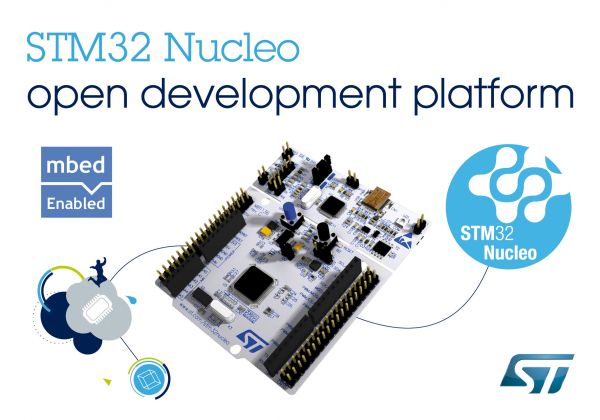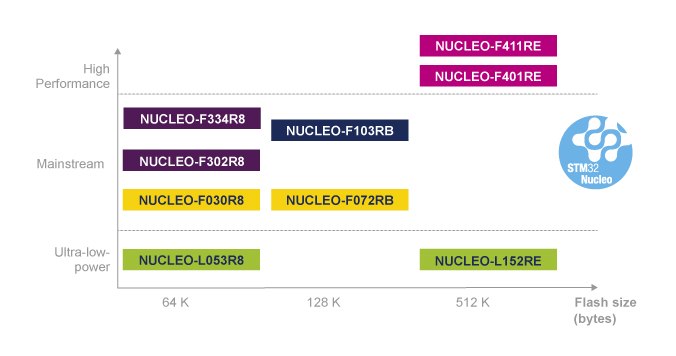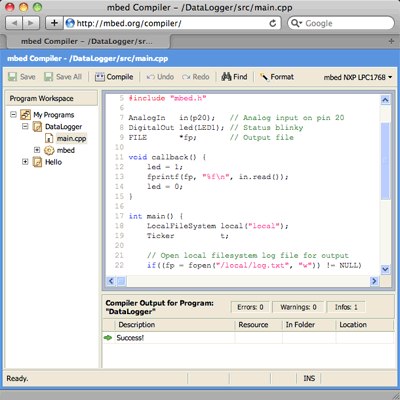Nucleo ST Developer Platform Overview with Nucleo-F401RE
ST Nucleo Evaluation Boards:

This is an open, low-cost, and easily extensible development debugging platform with a wide selection of custom expansion boards for the entire line of 32-bit STM32 microcontrollers of the ARM Cortex-M3 and Cortex-M4 architectures.

ST Nucleo boards give you the opportunity to choose performance, power consumption, and architectural features of the microcontroller from various combinations. The platform allows you to quickly, conveniently and easily study the features of the architecture and programming of the microcontroller, test your ideas, create prototypes with any microcontroller of the STM32 family.

The platform board is divided into two parts, a programmer and an evaluation board. If desired, the user can cut the board that does not affect the functionality of the platform.
The STlink-v2.1 programmer has a SWD connector on the CN4 pins (see the figure above) that allows you to use the programmer regardless of the evaluation board for all STM32 MKs; for this, it is enough to disconnect the board with the microcontroller from the programmer by removing the jumpers from the CN2 pin and so that they are not to lose, they can be worn on the GND CN11 and GND CN12 pins, ground pins, which in turn already have spare jumpers on the back of the board. It should be noted that the platform implements STLink version 2.1, which, like in version 2.0, in addition to the debugging programming port SWD (CN4), virtual COM -> Usart (CN3) has the peculiarity of working by default as removable Flash media, which is a very useful option for beginners that can program the microcontroller, sending to this media a binary firmware file (in this firmware version, no more than 20Kb) generated, for example, in an online development environment such as Mbed. The programmer also has a separately removed Usart connector (CN3 connector of RX and TX pins) that undeservedly missed from the public view and realizes data exchange with a PC via virtual COM, which saves money on a separate device such as CP2102 which costs about 300 rubles separately, which just pays for this money shipping costs for the Nucleo evaluation platform.

The Nucleo line of evaluation boards supports connections to the Arduino and ST Morpho connectors, which make it easy to extend the platform’s functionality. Connectors provide peripherals and shields from the widespread Arduino ecosystem, allowing developers to conveniently and easily add custom features and scale their project. ST Company also offers specialized boards X-NUCLEO-IDB04A1 , X-NUCLEO-IHM01A1 , X-NUCLEO-IKP01A , X-NUCLEO-NFC01A1 and other expansion cards - shieldsSelf-designed to support features such as Bluetooth® LE or Wi-Fi®, GPS, audio recording amplification, MEMS microphones, proximity sensors and wireless control.
In the first photos, the evaluation boards had the quartz X2 and X3 needed to redefine the frequency of the data bus, microprocessor, and peripheral interfaces; when buying Nuleo boards, users were disappointed in their absence.
In an official statement in response to dissatisfied user reviews about their absence on the final product, an ST spokesman said:
(yeah, for example X2 - smd !!?).
On this note, I would like to draw attention to the fact that Nucleo boards, although they represent the entire family of STM32 microcontrollers, are only younger models, in a case with 64 MK legs. This solution is a little contrary to the desire of the average person to have more and better, but on the other hand, it’s worth understanding that the Nucleo product is intended to be an affordable and simple evaluation platform for developers and is designed specifically to support mbed-enabled, which gives a decent advantage to the absence of such a filling as on Discovery boards, it is assumed that the target audience does not need as much peripherals and hardware of the microcontroller as on Discovery boards. In some ways, they are right, but they are missing the Russian market in something, and they do not control the prices of their products from official suppliers,
The Nucleo line is part of ARM mbed ™ , a popular and rapidly growing project in Europe , an online toolkit for quickly and easily creating an ARM-based product.

Thanks to mbed-enabled support, developers can use the Mbed platformopen source software, online development tools and infrastructure from mbed.org. It is worth noting the convenience and simplicity of using this resource, more precisely, I would say this is not just a resource, it is a developer’s social network where users share their libraries, code samples and projects. The resource has everything you need for a quick start and working with the evaluation board, a forum where users share their experience and help each other solve code debugging tasks, a large selection of libraries for working with almost the entire periphery of the microcontroller and expansion cards, FAQ section and the opportunity ask a question to both users and the manufacturer’s representative, communicate between users and much more.

Online compiler https://mbed.org/compiler, an integral part of this resource, which will relieve the headache of many novice developers with setting up the development environment and the compiler, making it possible not to delve into all the details of the STM32 architecture.
Simon Ford, director of IoT platforms at ARM, said:
It’s hard to answer which board to choose, since everyone has their own needs, someone plans to develop a specific device or use a specific family of microcontrollers (for example, cheap or low-consuming), but having no experience, I took the most productive board available at the time of purchase for training Nucleo-F401RE based on STM32F401RE, many users did the same, took several versions at once with different purpose microcontrollers, someone bought all the available models.
To date, the lineup is represented by 9 models, the oldest of which STM32 Nucleo-F411RE differs from the widely used in Europe and simply available in Russia STM Nucleo-F401RE large RAM memory (128 Kb against 96Kb) with a higher processor frequency (100MHz against 84MHz) , a large number of hardware-supported interfaces.
STM32 Nucleo-F030R8, STM32 Nucleo-F103RB, STM32 Nucleo-F401RE and STM32 Nucleo-L152RE boards are already available for order in Russia, STM32 Nucleo-F072RB, STM32 Nucleo-F302R8, STM32 Nucleo-F334R8, STM32 Nucleo-F334R8, L053R8 are available for order from abroad, at a price of $ 10.32 per unit.
PS Ready new post

This is an open, low-cost, and easily extensible development debugging platform with a wide selection of custom expansion boards for the entire line of 32-bit STM32 microcontrollers of the ARM Cortex-M3 and Cortex-M4 architectures.

ST Nucleo boards give you the opportunity to choose performance, power consumption, and architectural features of the microcontroller from various combinations. The platform allows you to quickly, conveniently and easily study the features of the architecture and programming of the microcontroller, test your ideas, create prototypes with any microcontroller of the STM32 family.

The platform board is divided into two parts, a programmer and an evaluation board. If desired, the user can cut the board that does not affect the functionality of the platform.
The STlink-v2.1 programmer has a SWD connector on the CN4 pins (see the figure above) that allows you to use the programmer regardless of the evaluation board for all STM32 MKs; for this, it is enough to disconnect the board with the microcontroller from the programmer by removing the jumpers from the CN2 pin and so that they are not to lose, they can be worn on the GND CN11 and GND CN12 pins, ground pins, which in turn already have spare jumpers on the back of the board. It should be noted that the platform implements STLink version 2.1, which, like in version 2.0, in addition to the debugging programming port SWD (CN4), virtual COM -> Usart (CN3) has the peculiarity of working by default as removable Flash media, which is a very useful option for beginners that can program the microcontroller, sending to this media a binary firmware file (in this firmware version, no more than 20Kb) generated, for example, in an online development environment such as Mbed. The programmer also has a separately removed Usart connector (CN3 connector of RX and TX pins) that undeservedly missed from the public view and realizes data exchange with a PC via virtual COM, which saves money on a separate device such as CP2102 which costs about 300 rubles separately, which just pays for this money shipping costs for the Nucleo evaluation platform.

The Nucleo line of evaluation boards supports connections to the Arduino and ST Morpho connectors, which make it easy to extend the platform’s functionality. Connectors provide peripherals and shields from the widespread Arduino ecosystem, allowing developers to conveniently and easily add custom features and scale their project. ST Company also offers specialized boards X-NUCLEO-IDB04A1 , X-NUCLEO-IHM01A1 , X-NUCLEO-IKP01A , X-NUCLEO-NFC01A1 and other expansion cards - shieldsSelf-designed to support features such as Bluetooth® LE or Wi-Fi®, GPS, audio recording amplification, MEMS microphones, proximity sensors and wireless control.
In the first photos, the evaluation boards had the quartz X2 and X3 needed to redefine the frequency of the data bus, microprocessor, and peripheral interfaces; when buying Nuleo boards, users were disappointed in their absence.
In an official statement in response to dissatisfied user reviews about their absence on the final product, an ST spokesman said:
Photos were taken from prototypes, and it is assumed that an internal RTC generator will be enough to solve most problems, if desired, the user can independently install external quartz
(yeah, for example X2 - smd !!?).
On this note, I would like to draw attention to the fact that Nucleo boards, although they represent the entire family of STM32 microcontrollers, are only younger models, in a case with 64 MK legs. This solution is a little contrary to the desire of the average person to have more and better, but on the other hand, it’s worth understanding that the Nucleo product is intended to be an affordable and simple evaluation platform for developers and is designed specifically to support mbed-enabled, which gives a decent advantage to the absence of such a filling as on Discovery boards, it is assumed that the target audience does not need as much peripherals and hardware of the microcontroller as on Discovery boards. In some ways, they are right, but they are missing the Russian market in something, and they do not control the prices of their products from official suppliers,
The Nucleo line is part of ARM mbed ™ , a popular and rapidly growing project in Europe , an online toolkit for quickly and easily creating an ARM-based product.

Thanks to mbed-enabled support, developers can use the Mbed platformopen source software, online development tools and infrastructure from mbed.org. It is worth noting the convenience and simplicity of using this resource, more precisely, I would say this is not just a resource, it is a developer’s social network where users share their libraries, code samples and projects. The resource has everything you need for a quick start and working with the evaluation board, a forum where users share their experience and help each other solve code debugging tasks, a large selection of libraries for working with almost the entire periphery of the microcontroller and expansion cards, FAQ section and the opportunity ask a question to both users and the manufacturer’s representative, communicate between users and much more.

Online compiler https://mbed.org/compiler, an integral part of this resource, which will relieve the headache of many novice developers with setting up the development environment and the compiler, making it possible not to delve into all the details of the STM32 architecture.
Simon Ford, director of IoT platforms at ARM, said:
“The hardware mbed-enabled STM32 Nucleo board gives ST users access to the extended mbed software ecosystem, development tools, and community that support the development of a new wave of intelligent electronic products.”
It’s hard to answer which board to choose, since everyone has their own needs, someone plans to develop a specific device or use a specific family of microcontrollers (for example, cheap or low-consuming), but having no experience, I took the most productive board available at the time of purchase for training Nucleo-F401RE based on STM32F401RE, many users did the same, took several versions at once with different purpose microcontrollers, someone bought all the available models.
To date, the lineup is represented by 9 models, the oldest of which STM32 Nucleo-F411RE differs from the widely used in Europe and simply available in Russia STM Nucleo-F401RE large RAM memory (128 Kb against 96Kb) with a higher processor frequency (100MHz against 84MHz) , a large number of hardware-supported interfaces.
| MK | CPU FPU | Flash | RAM | 12bit ADC | timers | I2C | USARTs | SPIs | SDIO | I2S |
| F401 | 84MHz | 512Kb | 96Kb | 10ch. | 10 | 3 | 3 | 4 | + | N / a |
| F411 | 100 MHz | 512Kb | 128Kb | 16ch. | 10 | 3 | 3 | 5 | + | 5 |
STM32 Nucleo-F030R8, STM32 Nucleo-F103RB, STM32 Nucleo-F401RE and STM32 Nucleo-L152RE boards are already available for order in Russia, STM32 Nucleo-F072RB, STM32 Nucleo-F302R8, STM32 Nucleo-F334R8, STM32 Nucleo-F334R8, L053R8 are available for order from abroad, at a price of $ 10.32 per unit.
PS Ready new post
